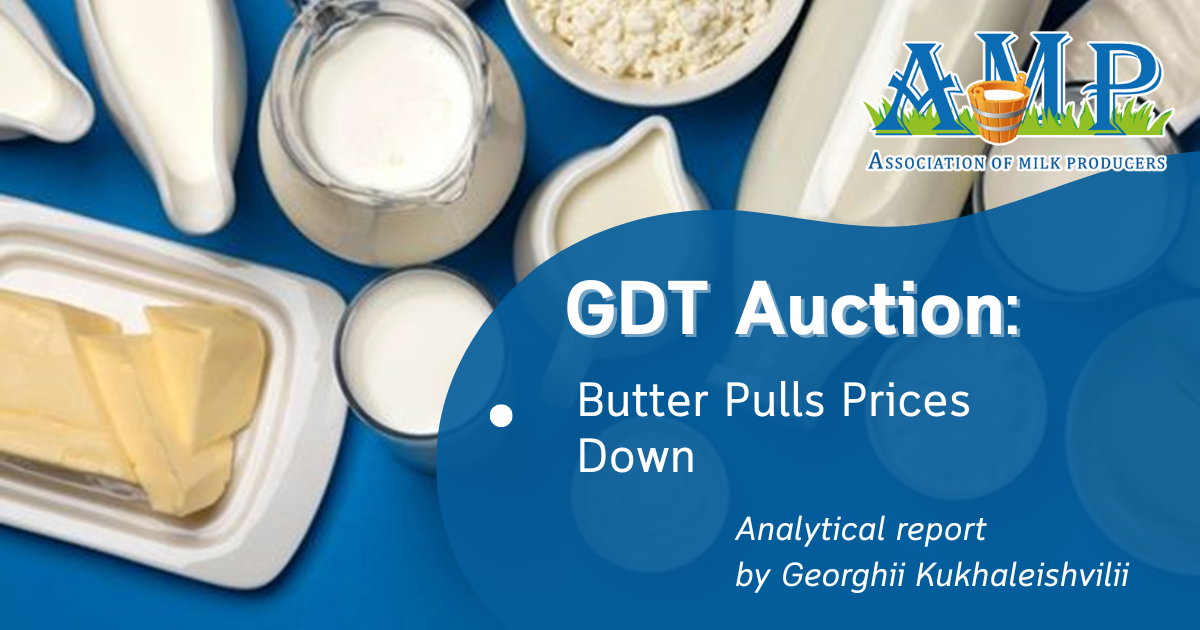A drop in prices for butter, cheese, and skim milk powder affected the auction results, reports Georghii Kukhaleishvili, an analyst at the Association of Milk Producers. On Tuesday, August 19, the 386th GDT auction took place, with the price index reaching 1264, a decrease of 4 points (-0.3%) from the previous auction.
The average price for dairy products was $4,291 per tonne, which is $42 more than the previous auction's results. During the auction, 36,553 tonnes of commodities were sold, which is 487 tonnes less than the last auction. The minimum offering was recorded at 34,309 tonnes, and the maximum at 41,791 tonnes. A total of 160 dairy market operators participated, which is 6 fewer companies than on August 5.
According to the auction results, the price for anhydrous milk fat was $7,078 per tonne, a 0.1% increase compared to the previous auction. According to the USDA, prices for milk fat across the board decreased in Europe, which may explain the modest increase compared to the previous auction.
According to HTF Market Intelligence, the global anhydrous milk fat market will grow at a compound annual rate of 6.7% from 2025 to 2032. According to AInvest, China and Middle Eastern countries are adopting Western baking culture, which is leading to an increase in milk fat imports. The auction organizers predict a 0.6% decrease in the price of anhydrous milk fat in September and October.
The price for butter at this auction was $7,144 per tonne, a 1% decrease compared to the previous auction. According to the USDA, demand for butter in the US has slowed, and its production is decreasing because some companies are modernizing their equipment. In the country's Northeast, due to reduced milk yields, raw milk is being used for the production of pasteurized milk and cheese. Demand for pasteurized milk in the country is growing at the start of the new school year. In export markets, there is quite active demand for American 82% fat butter, and its warehouse stocks in the US are limited.
In Europe, the supply of cream is seasonally limited, which is holding back butter production. The lower price limit for butter has increased slightly due to stable domestic demand and limited product stocks. Butter prices in Oceania, conversely, have decreased amid an increase in milk yields at the beginning of the new season and a weakening of domestic demand. In export markets, cheaper American butter sells better than products from Oceania. According to the GDT organizers, butter prices may decrease by 3.8% in September and 1.3% in October.
The price for whole milk powder was $4,036 per tonne, an increase of 0.3% compared to the previous auction's results. The insignificant price increase likely occurred amid a new tender from the Algerian agency ONIL, which was held on August 14. As reported by Expana Markets, suppliers from Latin America and New Zealand sold about 40,000 tonnes of whole milk powder at the tender. Deliveries are planned for November 2025–January 2026. In Algeria, there is a high demand for whole milk powder from South American producers. As reported by the USDA, in Europe, demand for the product remains stable, but the seasonal reduction in milk yields is limiting production. Whole milk powder stocks are limited.
In Oceania, the price range for whole milk powder has decreased, and its production is recovering after a seasonal decline in June–July, when cows were transitioned to a "dry period." Export demand for the product is high, especially for fall deliveries during the peak milk yield season in Oceania. However, in the US, demand for whole milk powder is weak, and prices have decreased slightly across the board. Production is focused mainly on fulfilling current contracts, and spot market activity is minimal. According to the GDT forecast, whole milk powder prices are likely to increase by 0.8% in September but decrease by 0.4% in October.
Skim milk powder became cheaper, dropping to $2,756 per tonne (-1.8%). According to the USDA, demand for skim milk powder in the US is weak. Sales to Mexico are lower than a few weeks ago. Inventories are gradually increasing in the southwestern US due to weaker exports. In contrast, in Europe, demand is stable, and there is competition among buyers for available product batches. Skim milk powder stocks are low, and buyers are trying to purchase it in advance. According to Expana Markets, suppliers from the EU participated in the tender of the Algerian agency ONIL and secured large volumes of skim milk powder deliveries. Shipments of 35,000 tonnes of skim milk powder from the EU to Algeria are planned for November 2025–December 2026. There is export demand for skim milk powder from Oceania. Since the beginning of the year, New Zealand has increased its product shipments to China, and producers from South America have increased theirs to Brazil. The auction organizers expect the price for skim milk powder to increase by 0.4% in September and decrease by 2.6% in October.
Cheddar cheese became cheaper, dropping to $4,548 per tonne (-0.5%), and mozzarella cheese became cheaper, dropping to $4,447 per tonne (-2.7%). According to the USDA, demand for Cheddar from Oceania has slightly decreased, as American Cheddar is cheaper and more competitive in export markets. However, American cheesemakers are facing certain difficulties, as more raw milk is being directed to be processed for pasteurized milk due to growing demand from schools at the start of the academic year. Demand for European cheeses has begun to increase with the approach of autumn. An increase in sales is expected in the HoReCa and retail sectors. Demand for cheese is active in the countries of Southern Europe. The auction organizers assume that Cheddar cheese prices may decrease by 3.2% in September and 3.1% in October. A 2.7% decrease in the price of mozzarella cheese is projected for October.
The next GDT auction will take place on September 2.
Press service of the Association of Milk Producers
Follow us on LinkedIn
Related News


